Visitors to urban terraces

Terraces in cities can be really surprising. Depending on the plants we have, different species of insects might be attracted to them. We can also have unwanted pests that attack them and even kill them. But there are also some visitors that may amaze us: a spectacular caterpillar of the death’s-head hawkmoth going unnoticed between the leaves of an olive tree or a leafcutter bee trying to make its mark on a Virginia creeper.
In my west-facing flat terrace we have some plants I take care of daily, not only for their beauty, but also their meaning. Some of them have been with us for years and they hold a really special sentimental value. That is why I keep an eye on them to solve any problem they may face related to pests, lack or excess of irrigation, fertiliser application, the drying action of the west wind…

Death’s-head hawkmoth
Some years ago, one morning in early November, I was watching my olive tree (Olea europea L), which I have had in a pot for twenty years. It is an olive tree from Cocentaina (Alicante, Spain) probably of the ‘Blanqueta’ variety, the most common in these regions. When I was looking at the leaves something caught my attention. It was not the colour, but the strange shape they had. I took a closer look and I realised it was not a strange leaf, but a caterpillar. At home we fed the larva with olive tree leaves for weeks until it changed to a chrysalis. On the 1st of January 2015, the butterfly emerged and we tried to feed them with honey. It survived for several days and on the 7th of January, we saw it dead. It was not buried, therefore, it did not spend time in absolute darkness as it is required during the pupal stage, so perhaps it did not develop properly and its wings did not seem suitable for flying.
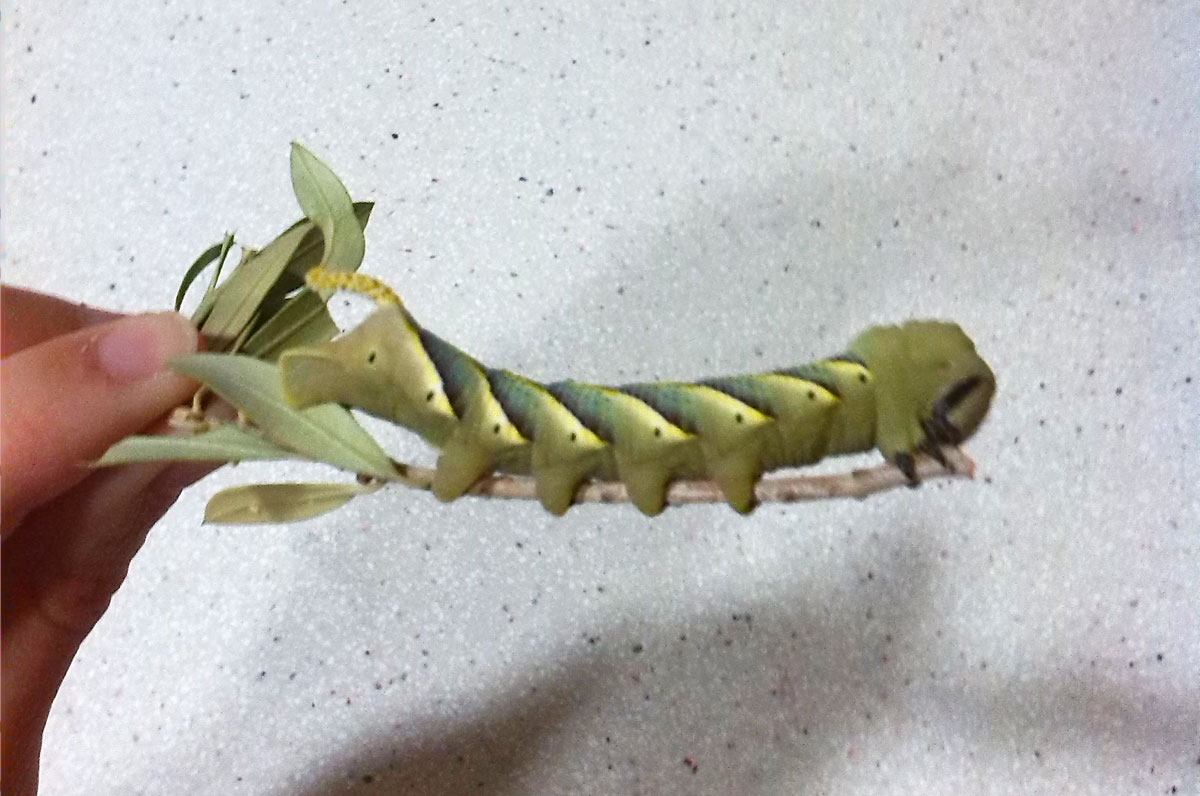
Caterpillar of the death’s-head hawkmoth, Acherontia atropos. You can check its size in comparison to the hand holding the olive twig. /Carmen López Valiente
This is not something unusual. It is common to find people asking questions in gardening forums about «a green and big worm» they have found in their vegetable gardens, window boxes or urban terrace gardens. They are usually isolated specimens. This one was a caterpillar of the death’s-head hawkmoth (Acherontia atropos Latreille), a nocturnal moth that belongs to the sphinx family.
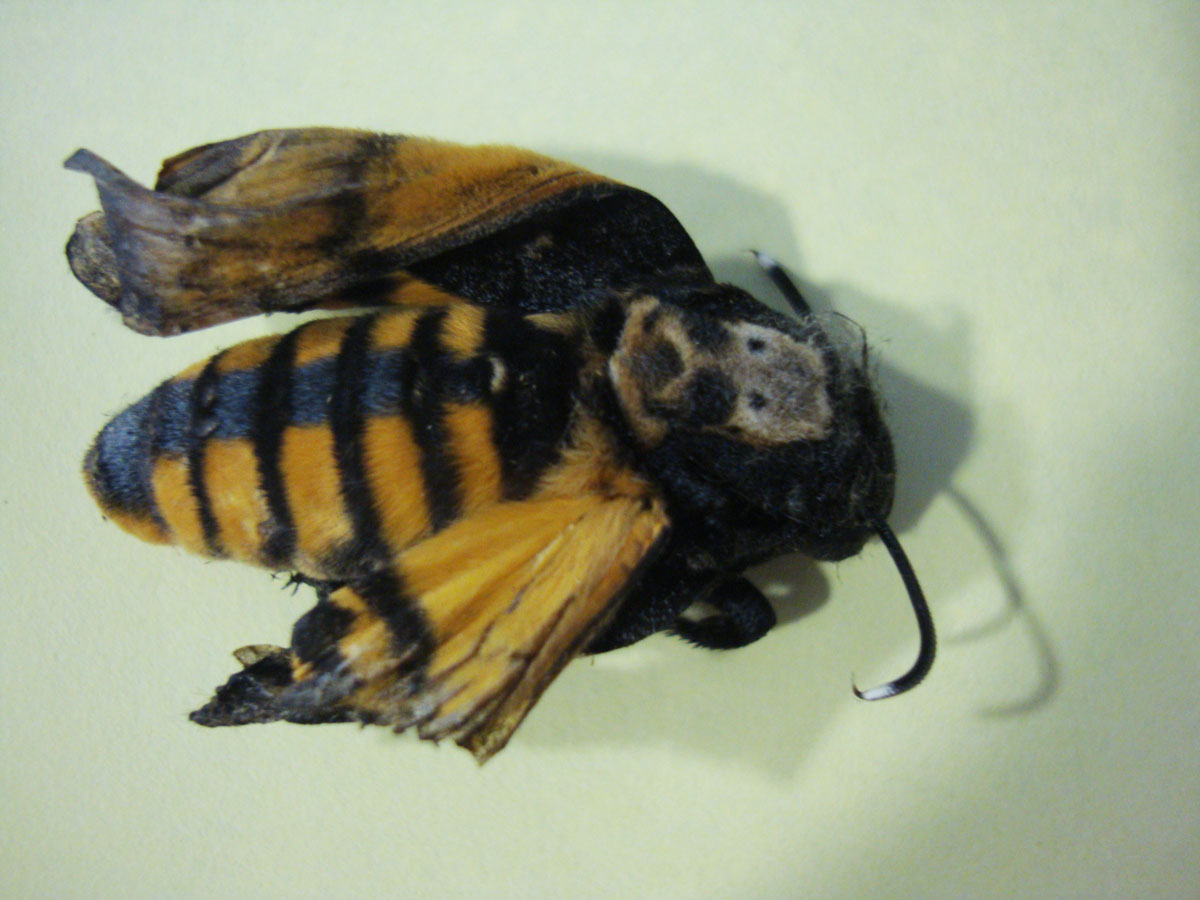
This species has always been associated with bad luck or death in literature and cinema. Bram Stoker mentioned it in Dracula and it also appears in the film The Silence of the Lambs by Jonathan Demme (the chrysalises are found in the mouth of the victims). This connection between Acherontia atropos and death dates back to the moment when the scientific name was given. Indeed, the name of its genus, Acherontia, comes from the river Acheron, crossed by the ferryman Charon when he carried the dead to the kingdom of Hades. The species atropa refers to one of the three Moirai (or Parcae in Roman mythology), specifically Atropos, the one who cut the thread of life.

On the left, you can see the poster for the film The Silence of the Lambs (J. Demme, 1991). On the right, the bas-relief representing the figure of Atropos, one of the three Moirai or Parcae./ Orion Pictures / Tom Oates – Wikipedia
The death’s-head hawkmoth is native to tropical Africa and it migrates between May and June to spend the summer in Europe. Its altitudinal preference ranges from sea level to 1,800m, and regarding latitude, it is increasingly seen in northern territories further away from the equator. Due to global warming its distribution and behaviour is changing and perhaps that is the reason why I found the caterpillar in Valencia city when it was already autumn. Caterpillars measure 12-13 cm and they have very similar colours to those of the leaves from olive trees: different shades of green that make them go unnoticed. They consume leaves from plants of the Solanaceae family, such as the tobacco leaves (Nicotiana tabacum L.), or potato (Solanum tuberosum L.), but they also consume leaves of olive trees, vines (Vitis vinifera L.) and some ornamental plants. This caterpillar has the particularity of being able to emit some sounds and bite when it feels threatened.
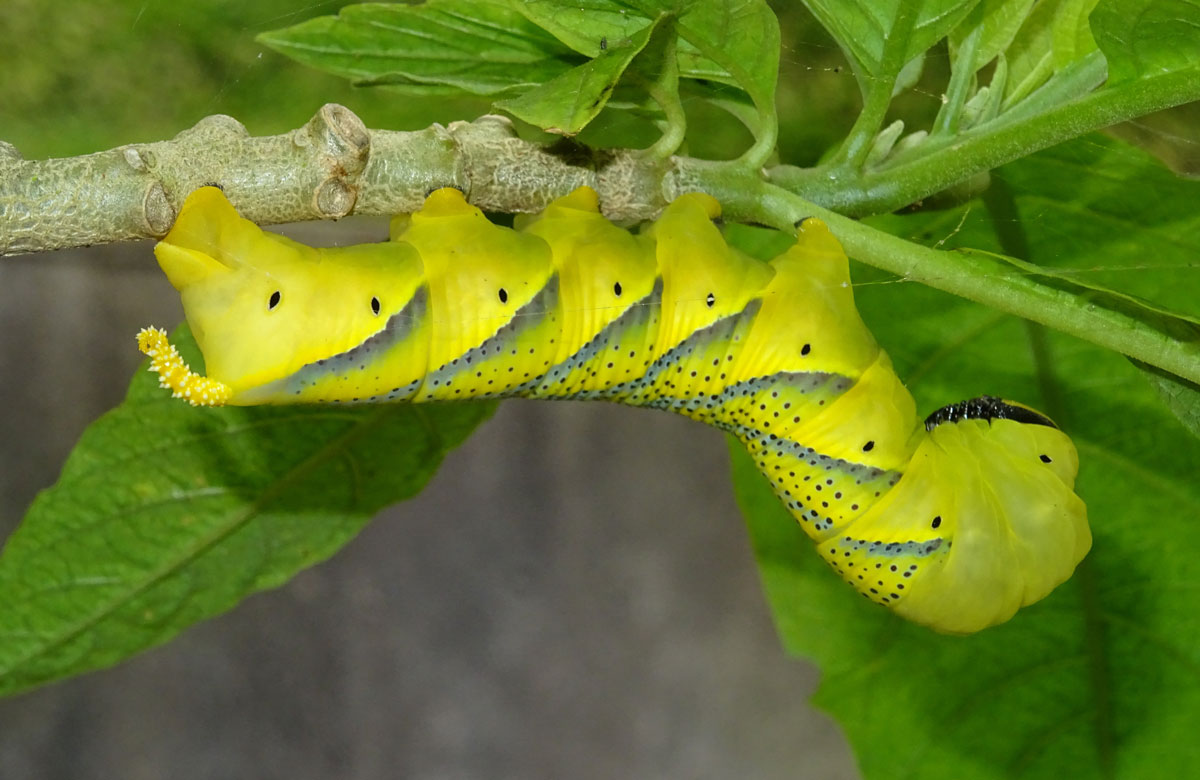
Caterpillar of the death’s-head hawkmoth feed on plants that belong to the Solanaceae family./ Pxhere
Its reproductive cycle is curious. The hawkmoth lays its eggs in a leaf and when they hatch, the caterpillar will feed and after four moults it will turned into a pupa or chrysalis. During this stage it will be buried in the ground, at a depth of more than 15cm. After the pupal stage in the ground, a black, grey and yellow-orange hawkmoth emerges with a skull-like pattern on the upper part of its thorax, which gives it its common name: the death’s-head hawkmoth. In the adult stage, it becomes a fast insect, reaching 50km/h, and large, it measures between 9-13cm (the female is bigger than the male). This hawkmoth can develop two generations in one year.

Death’s-head hawkmoth. / Mariposas – wiki
It is harmless to humans, but causes economic damage when it attacks honeycombs, especially in Africa. To prevent bees from attacking it, it has a foolproof method: it impregnates itself with fatty molecules that have the same odour as the bees. That way it is not detected by them, going unnoticed inside the honeycomb. Even so, its thick cuticle protects it from possible stings. In addition to honey from honeycombs, it also feeds on the nectar of some flowers such as jasmine and carnations.
In Spain, however, it is not considered a threat. It may defoliate some olive twig or eat some tender stem of Solanaceae plants (potatoes, peppers, tomatoes, aubergines). Usually, it is not necessary to use pesticides in the field, as it can be removed by hand.
Leafcutter bee
Another of my favourite plants on the terrace is the Virginia creeper or Victoria creeper Parthenocissus quinquefolia (L.) Planc. This climbing plant from North America (its habitat extends from Canada until México) is
deciduous. The bright, intense green leaves have five folioles and when autumn comes, they turn into a reddish colour. It is at that time of the year that the amount of light decreases, chlorophyll production drops and yellow orange and reddish pigments (carotenoids and flavonoids) are seen, which will eventually degrade too. This is the reason why it is a very decorative plant that can be used for covering walls, grilles and trellis. It is also easy to grow and maintain. Their flowers and fruits bloom in spring and are of little ornamental value. In the city it is often attacked by the citrus mealybug (Planococcus citri Risso) just before leaves grow, so it is easy to get rid of these hymenopterans insects with a little patience as they are easy to detect.
But it was not the citrus mealybus that worried me. Every spring we saw our Virginia creeper had some “bites”, perfect cuts, on their folioles; however, we had never seen any caterpillars, snails or birds that could be responsible for the “bites”. We thought it might be some nocturnal species. Then, at the beginning of April this year, we saw an insect that looked like a bee. The big surprise came when it landed on the leaves of the Virginia creeper and made a perfect cut of about 1-3cm and flew away with it between its legs. It was the leaf-cutter bee.
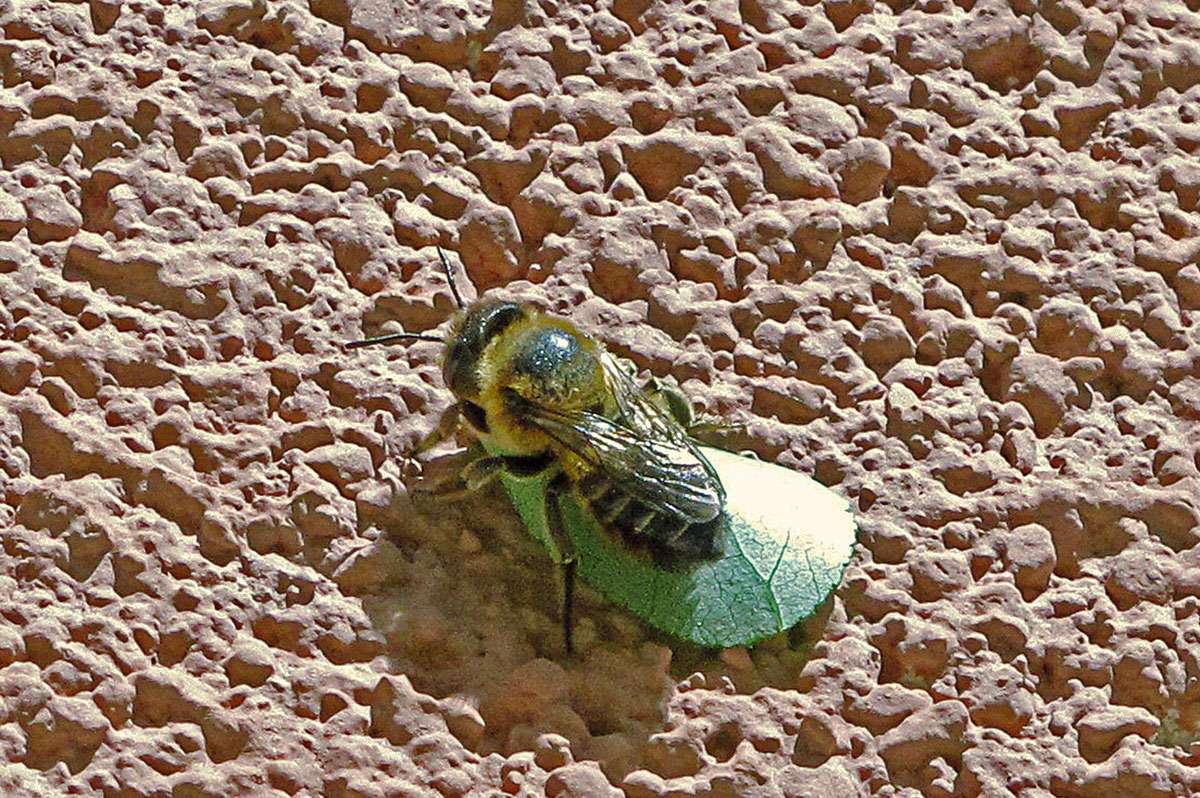
Leaf-cutting bee carrying its “loot”./ Jacilluch – Wikimedia
The leaf-cutter bee (Megachile centuncularis L.) is a hymenoptera very similar to the honey bee (Apis mellifera L.) but does not live in groups. The female normally builds a nest out of leaf cuts and lays her eggs there together with some food for future larvae. They can be built anywhere: holes in walls and on the ground, in pots, tiles, etc. Its bites are not dangerous, it is not aggressive to people, and it is usually solitary. It is not harmful to garden plants such as roses, bougainvillea, wisteria, etc, as it does not kill the plant it attacks, because it does not usually reach the central nerves of the leaf. It will, however, live “trimmed”. In other words, it only causes aesthetic damage.
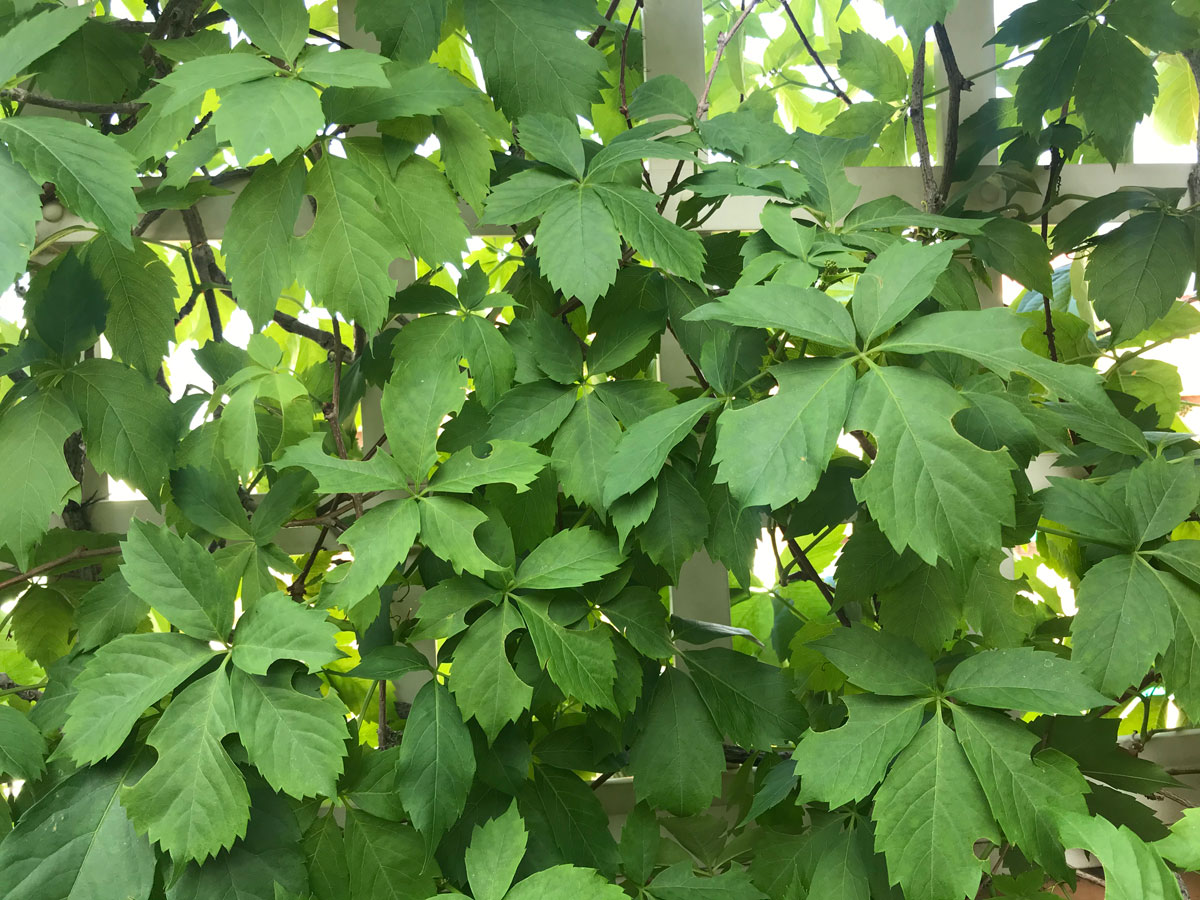

This visitors to urban terraces are striking and curious, but they are not considered as a pest. There is no need to use insecticides on plants, they are not annoying or dangerous fauna. In fact, they remind us about the importance of plant biodiversity without leaving our house. They play their role in the life cycle, even if part of it takes place on a city terrace.
Bibliografia
Cuadernos de tecnología agraria [internet] (consultat l’1 de maig, 2020). Disponible a www.ivia.gva.es Mariposa de la muerte, Acherontia atropos y su llamativa estampa [internet] (consultat el 4 de maig, 2020). Disponible a invertebrados.paradais-sphynx.com Información sobre Acherontia atropos [internet] (consultat el 4 de maig, 2020). Disponible a www.agrologica.es Presencia de la esfinge de la muerte en plantones de olivar [internet] (consultat el 4 de maig, 2020). Disponible a www.juntadeandalucia.es Cochinilla algodonosa [internet] (consultat el 4 de maig, 2020). Disponible a www.koppert.es Te presento a la abeja cortadora de hojas [internet] (consultat el 4 de maig, 2020). Disponible a www.joseeljardinero.com





